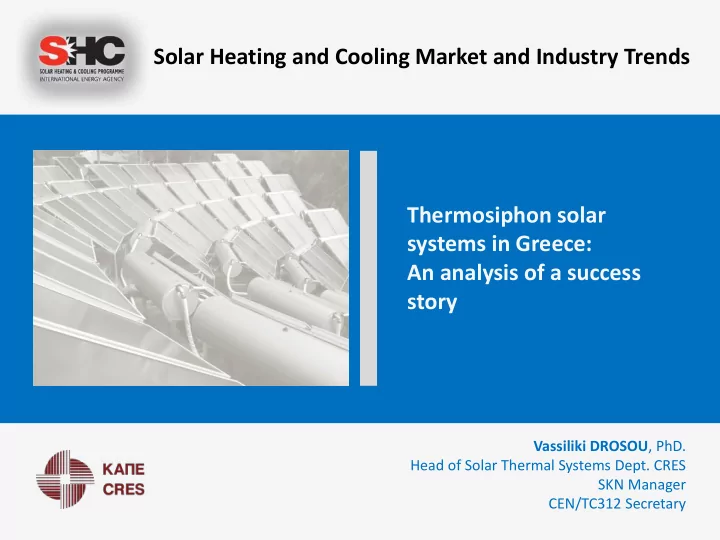

Solar Heating and Cooling Market and Industry Trends Thermosiphon solar systems in Greece: An analysis of a success story Vassiliki DROSOU , PhD. Head of Solar Thermal Systems Dept. CRES SKN Manager CEN/TC312 Secretary
Greece In Greek: Ελλάδα , known also as Hellas Population: approx. 10.7 million Capital: Athens Area: 131,957 km 2 Located in Southeast Europe, on the southern tip of the Balkan Peninsula GHI: 1450 kWh/m 2 ~ 1800 kWh/m 2
Solar Thermal: key figures 2019 NEW TYPICAL SOLAR INSTALLED CAPACITY SYSTEMS SYSTEM FRACTION 361,500 m 2 3,407 MW th Thermosiphon 80-90% collector area 4,867,500 m 2 150-300 l of the yearly storage sanitary hot collector area 10% increase 2-4 m 2 water needs of compared to 3,325 GWh/a a single family selective flat 2018 energy yield plate collector
Domestic and exporting market Greek manufacturers export more than 50% of their production
Importing markets for Solar Thermal products (2019)
THERMOSIPHON SYSTEM Highly efficient Easy to install Independence from other users Good value for money Long life Low maintenance Safe
Growth of the branch Greek market Competitive Extended
Historical milestones 1970s: Domestic manufacturing Establishment of Greek solar thermal industry – EBHE (GSIA) 1970s: Impact of rising energy prices due to the oil crises 1980s: Successful big installations 1980s: Promotional campaigns and incentives in form of tax reductions and low interest loans
CEN TC 312 Thermal solar systems and components Solar Keymark Standardization Of active SKN licenses 10% are awarder to Greek products
Ownership rate in Greece in excess of 75%. The typical Greek Buildings consumer prefers a high degree of autonomy Most urban buildings feature flat roofs, highly suitable for installation
“Regulation on the Energy Performance of Buildings” 60% of hot water needs in domestic sector must covered by a solar thermal system (since 2010) “Saving Energy at Home I and II" programs” 70% installation costs of a solar thermal system for hot water production are funded by up to 70% PV with solar thermal Governmental support The installation of PVs is allowed only upon the prerequisite that a solar thermal system is being used for hot water production
New buildings Renovations After economic recession Electricity and oil price increase Price reduction of solar thermal products
Other factors Improved e – commerce & Environmental manufacturing broad distribution concerns processes network of shops by the consumers
Numbers to remember 1700kg/a CO 2 avoided emissions by a thermosiphon system 1400kg/a CO 2 avoided emissions by an electric car Solar collector ~ 675kgr CO 2 /m 2 y Electric car ~ 120gr/km.
References • DROSOU V., TRAVASAROS C., PAPADOPOULOS, A.M ., Thermosiphon solar systems in Greece: An analysis of a success story, 13 th Eurosun International Conference on Solar Energy for Buildings and Industry, 1 – 4 September 2020, Virtual Conference (Invited presentation) • EBHE www.ebhe.gr Pictures: Cover SOLE, p.3 CALPAK, p.4 SOLE, p.6 (up) PAPAEMMANOUEL, p.6 (down) COSMOSOLAR, p.7 MALTEZOS, p.10 SOLE, p.11 MELPO, p.13 SOLE, p14 PAPAEMMANOUEL. Thank you for supporting solar thermal technology! drosou@cres.gr
Recommend
More recommend